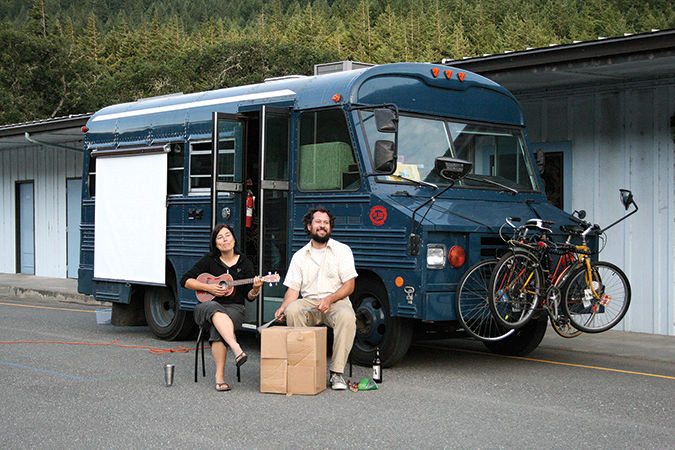Thirteen years ago, Paolo Davanzo had a vision: education, community-building, filmmaking.
“My parents died when I was very young. They were altruists and social activists. I wanted to perpetuate their beauty and their power and their love.”
Thirteen years ago, Lisa Marr had just made her first film and was looking for a place where she could show it.
“There wasn’t anything in L.A.,” says Lisa, who came up with punk rockers and DIY folks. “A place where you could bring all kinds of people together and show all kinds of films without people feeling like they didn’t know the secret password.”
The day Paolo opened the Echo Park Film Center — a down-home “community media arts cooperative providing equal and affordable access to film/video education and resources” — Lisa walked in. “I thought, ‘Who is this guy?’”
They’ve been partners ever since.
“There is a magic in the story,” Lisa allows. “Your life can change in an instant by a chance encounter.”
Magic, an exceptional capacity for risk-taking and service, and masses of no-nonsense hard work.
“We found our original mission statement a few years ago,” Paolo offers. “Provide free classes for kids and seniors, provide a screening location for non-traditional films, develop an artist’s residency program. And all these things have come true.”
In the fall of 2010, inspired by film-makers from the ‘20s who, in cities around the world, had gone out with cameras and captured the then-new phenomenon of urban life, Paolo and Lisa decided to revisit the idea as a youth project. They invited kids ranging in age from 10 to 19 to participate, taught them to shoot 16mm film and produced a black-and-white documentary about L.A. called “The Sound We See.”
The film starts at midnight and goes to the following midnight. Each hour of the day becomes a minute on film. The kids picked a part of Los Angeles that to them represented a certain time of day or night — the L.A. River, Venice Beach, the Griffith Park Observatory — filmed it, and worked with a group of professional musicians who composed the score. It was performed live, the way it would have been done in the ‘20s.
“The project was such a success that we ended up taking it on the road. It’s become our signature project in a way. We did one in Rotterdam, we did one in Hanoi, we did one in India last year.”
The latest was in Old Crow in the Arctic Circle, a native indigenous community with a population of 250.
There’s no road. You can only fly in or come in on the river. They were there for two-and-a-half weeks last fall.
They taught people, many of whom had never held a camera, to shoot, edit, and process film using a natural mixture of coffee, Vitamin C and washing soda. In Old Crow, they incorporated cranberry juice and pine needles into the processing mixture.
“To see these people who were so resilient and so determined to preserve their way of life was phenomenal,” Lisa says. “There are incredible images of caribou hunting and gathering wood for the winter and the sled dogs. Part of the soundtrack was some of the elders and the younger kids speaking Vuntut Gwitchin, the native language, which is fast disappearing. The age range for that project was 5 to 82. They’re all talking about their community and what it means to them.”
Adds Paolo, “Anyone can walk through that door and be in on what we do here. It’s word of mouth, it’s community, it’s reciprocal. We’re not snobs. We have flip cameras, we have GoPros. But analog film is actually a living thing. It’s telling a living story. And our hearts respond to it.”
Recently they gave a TEDx talk at UCLA.
But they don’t advertise.
They see a need — and with verve, exuberant creativity, and heart, they quietly fill it.
Several years ago, filming at the Rosebud Reservation in South Dakota, they were deeply moved by the beauty and the hardship of living in poverty. “We told the people, ‘Wow, you have some stories to tell.’ And they said, ‘Yeah, but we don’t have anything. We don’t have cameras. We have one computer; it’s in the rez office.’”
Lisa and Paolo realized they had to come up with a way to bring the film center on the road. They wrote a grant, bought an old school bus, converted it to run on vegetable oil, and took it on the road.
“The Filmmobile has toured to New York and back, we’ve been to Mexico, spots in Canada. Free workshop every day, free screening every night, live music.”
Their latest innovation is The Filmcycle, a Dutch-style bicycle with a box on the front that can fit a little generator, a screen and a projector.
“Last May we pedaled down to MacArthur Park and did a Mother’s Day screening: a documentary by a guy called Les Blank about norte√±o music. It was quite beautiful because there were a lot of homeless people from Mexico and Central America and all these men just kind of gathered around. People were singing along, they were saying, ‘Thank you so much, this is our music.’
“That’s what we’re about, really. That desire to connect with the motherland.”

